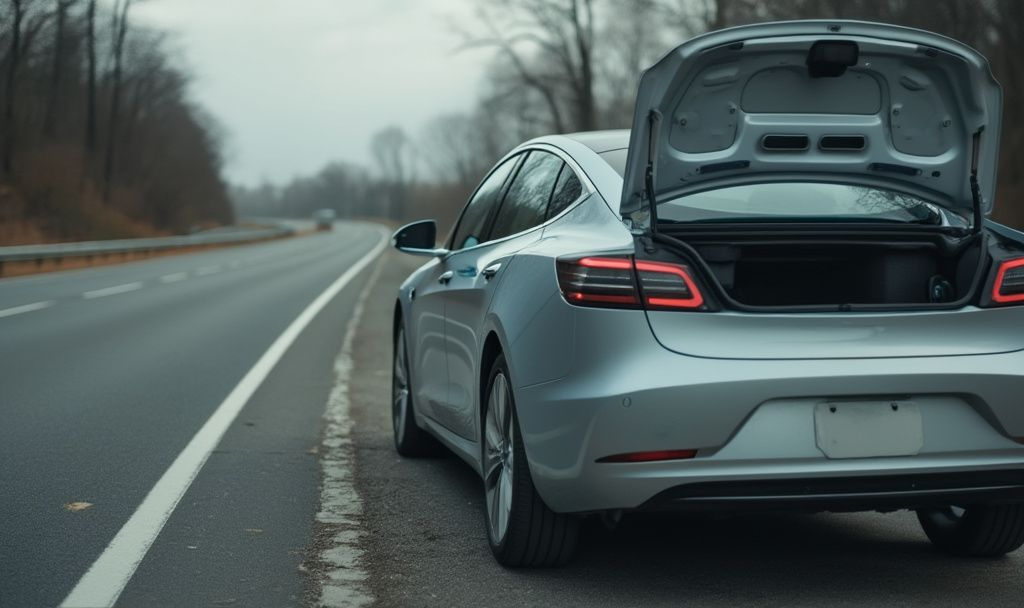Curious about what happens when an EV’s battery runs out? If your electric vehicle reaches zero charge, don’t worry—it’s not the end of the road. Learn how modern EVs are equipped with features to help manage low battery situations and ensure driver safety.

As electric vehicles (EVs) become a common sight on roads, many drivers worry about running out of battery power while driving. It’s a concern that often comes with transitioning from gasoline to electric, prompting questions about what happens when an EV’s battery completely drains. This anxiety, sometimes referred to as “range anxiety,” is a genuine issue for many current or prospective EV owners and is worth exploring for peace of mind.
Understanding What Happens When an EV Runs Out
If an EV’s battery reaches zero charge, the vehicle will eventually stop, much like a gas-powered car running out of fuel. When this happens, most EVs automatically shift into a mode that maximizes the remaining battery power for critical functions. This means the vehicle might slow down gradually before coming to a complete stop, usually giving drivers some warning and the opportunity to pull over safely.
Modern electric cars are designed with the driver’s safety and convenience in mind, featuring warnings and indicators long before the battery charge becomes critically low. Dashboards typically provide information on remaining mileage, and some systems include audible alerts to remind drivers to charge soon. With these features, running entirely out of battery should be a rare occurrence.
Dealing with a Drained EV Battery
If you do find yourself with a completely discharged battery, several options are available. Roadside assistance services aimed specifically at EVs can help by either towing the vehicle to the nearest charging station or providing on-the-spot charging if available. Many automakers offer proprietary roadside assistance and apps to locate charging services quickly.
Technology tools such as route planning apps can also prevent you from running out during a trip. These apps help identify available charging stations along the way and provide real-time updates on station availability. Moreover, battery health monitoring apps can offer alerts on your phone when it’s time to recharge, helping you plan effectively.
Reducing Range Anxiety
Range anxiety often stems from uncertainty about battery longevity and charging infrastructure. Thankfully, advancements in battery technology have helped extend the life of electric car batteries, which are now generally made to last between 15 and 20 years with minimal annual degradation. Regular maintenance and mindful charging habits, such as avoiding excessive use of DC fast charging, can further preserve battery health [source].
More and more charging stations are being installed worldwide, and public policy supports ongoing infrastructure expansion. This growth not only alleviates range anxiety but also makes long EV journeys more practical. Understanding ecosystem advances and utilizing current technologies can mitigate apprehensions around battery depletion.
Industry and Policy Efforts
Vehicle manufacturers, alongside roadside assistance providers and charging network companies, actively work to address EV-related concerns. Innovations, such as improved battery warranties and comprehensive emergency support services, demonstrate the industry’s commitment to easing consumer fears. Most manufacturers offer warranties that cover 8–10+ years of battery life, ensuring peace of mind for new EV owners source.
These efforts are complemented by public initiatives that promote the widespread deployment of fast chargers and encourage policies to protect EV users in distress. As a societal shift towards sustainable transportation continues, support from both government and industry ensures that fears of being stranded become a thing of the past.
The Bigger Picture for EV Owners
Understanding what happens when an EV’s battery runs out is crucial for comfort and confidence. As discussions around EV practicality and infrastructure readiness progress, users can stay informed by leveraging available tools, services, and technological advancements. In this evolving landscape, being prepared not only enhances the EV experience but also supports a broader cultural shift towards sustainable energy.
The transition to electric vehicles is part of a significant environmental and technological change. By addressing these common concerns and investing in proper planning and resources, drivers can enjoy the benefits of EVs with minimal worry and greater assurance in their vehicle’s capabilities source.
FAQs
What happens when an EV’s battery runs out?
When an EV’s battery runs out, the vehicle will stop, but it usually gives the driver a warning to pull over safely first.
How can I prevent my EV from running out of battery?
You can prevent your EV from running out of battery by using route planning apps that identify available charging stations and by monitoring your battery’s health and charge level.
What should I do if my EV’s battery is completely drained?
If your EV’s battery is completely drained, you can use roadside assistance services to tow the vehicle to a charging station or receive on-the-spot charging if available.
Why do some people experience range anxiety with EVs?
Range anxiety is experienced due to concerns about limited battery life and the availability of charging infrastructure, particularly during long journeys.
How are automakers addressing the issue of EV battery depletion?
Automakers address EV battery depletion by designing vehicles with safety alerts, offering roadside assistance, extending battery warranties, and promoting infrastructure growth.
